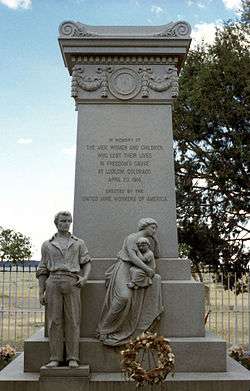Ludlow Tent Colony Site
|
Ludlow Tent Colony Site | |
 | |
 | |
| Location | Del Aqua Canyon Rd., Ludlow, Colorado |
|---|---|
| Coordinates | 37°20′22″N 104°35′00″W / 37.33944°N 104.58333°WCoordinates: 37°20′22″N 104°35′00″W / 37.33944°N 104.58333°W |
| Area | 40 acres (16 ha) |
| Built | 1913 |
| Architect | Sullivan,Hugh |
| NRHP Reference # | 85001328[1] |
| Significant dates | |
| Added to NRHP | June 19, 1985 |
| Designated NHL | January 16, 2009[2] |
Ludlow Tent Colony Site is an area in Ludlow, Colorado associated with the Ludlow Massacre that was designated a U.S. National Historic Landmark on January 16, 2009. It is an archeological site.[3][4]
The press release reads:
Ludlow Tent Colony, Ludlow, CO, is nationally significant in the history of industry for its association with the Ludlow Massacre, a pivotal event in American history that culminated in the destruction of the tent colony and the deaths of two women and eleven children on April 20, 1914. The tent colony originated when coal miners and their families were evicted from company housing during a strike that began in September 1913. The colony, or camp, was established by the United Mine Workers of America on vacant land near the mines and the small community of Ludlow. On April 24, a truce was declared and representatives of the miners and the mine owners med to discuss a “peace with justice.” In 1916, the United Mine Workers of America purchased the 40-acre site of the Ludlow Massacre, and two years later, a monument commemorating the massacre was built. Since then, union rallies and commemorations have become regular events at the site. The Ludlow Tent Colony Site is the first such strike camp to be archeologically investigated. This site is a prime example of what archeologists consider to be the perfect source of physical data because it is a short-term occupation that was destroyed by fire. Archeological investigation of the site to date is providing the means to gain a richer, more detailed, and more systematic understanding of the everyday reality of mining families of the period and throughout the United States.[3]
Ludlow massacre event

The Ludlow massacre was an incident in which 20 people died during an attack by the Colorado National Guard on a tent colony of 1,200 striking coal miners and their families on 20 April 1914. These deaths occurred after a day-long fight between strikers and the Guard. Two women and eleven children were among the dead.
Ludlow Monument
The Ludlow Monument is a monument on a 1.5-acre (6,100 m2) portion of the Ludlow Tent Colony Site.[4]
Preservation history
The site has been examined using historical archaeology techniques.[5] Colorado Senator Ken Salazar campaigned for National Historic Landmark status for the site, pledging in a press release that he would introduce senate legislation for the site to be named a National Historic Landmark.[6] In 1960 the very first NHLs were designated by congress, but in the 1960s the process was routinized to be handled by the Department of the Interior. NHLs are declared by the U.S. Secretary of the Interior.
The property was listed on the National Register of Historic Places in 1985.[1] It was designated a National Historic Landmark in 2009.[2]
References
- 1 2 Staff (2009-03-13). "National Register Information System". National Register of Historic Places. National Park Service.
- 1 2 "Ludlow Town Colony Site". National Historic Landmark summary listing. National Park Service. Retrieved 2010-02-21.
- 1 2 "Interior Secretary Kempthorne Designates 9 National Historic Landmarks in 9 States". Department of the Interior. 2009-01-16.
- 1 2 R. Laurie Simmons, Thomas H. Simmons, Charles Haecker, and Erika Martin Siebert (May 2008). National Historic Landmark Nomination: Ludlow Tent Colony Site (pdf). National Park Service.
- ↑ Wood, Margaret C. (September 2002). "Moving Towards Transformative Democratic Action Through Archaeology". International Journal of Historical Archaeology (Netherlands: Springer) 6 (3): 187–198. doi:10.1023/A:1020385120291. ISSN 1573-7748.
- ↑ "Senator Salazar Vows to Help Make Ludlow Tent Colony Site a National Historic Landmark". Press release, U.S. Senator Ken Salazar. 2008-01-23.
External links
| ||||||||||||||||||||||||||